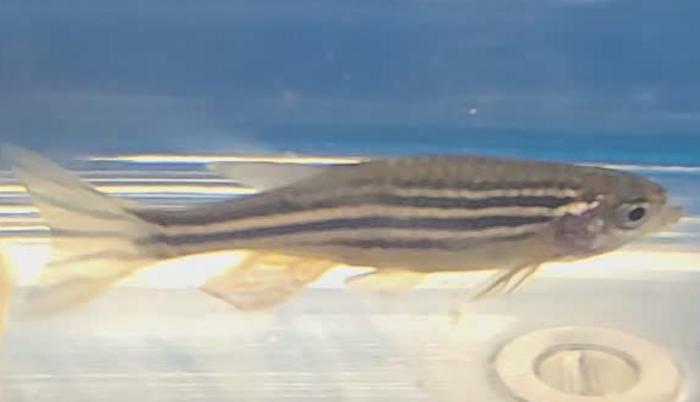
Zebrafish, a pivotal model organism in various fields of biological research, have long astonished scientists with their remarkable sensory capabilities. Among these, the ability of zebrafish to perceive color and brightness through their pineal gland—a small yet crucial organ located at the top of their heads—has opened new avenues for understanding visual processing in non-mammalian vertebrates. Recently, researchers from Osaka Metropolitan University unveiled critical insights into the mechanisms underlying this fascinating form of light detection.
The pineal gland, traditionally associated with regulating circadian rhythms, exhibits a unique adaptation in zebrafish. Unlike mammals, which primarily utilize photoreceptor cells in the retina for vision, bony fish employ their pineal organ to detect light stimuli. The research team, led by eminent Professors Akihisa Terakita and Mitsumasa Koyanagi, concentrated their efforts on a novel type of photoreceptor cell within the pineal gland that is responsible for this capability. The pivotal protein in this cellular mechanism, known as parapinopsin 1 (PP1), alters states in response to varying light wavelengths, allowing the fish to perceive different colors.
The significance of color detection hinges on the intricacies of PP1 cell activation. In a striking revelation, the researchers found that PP1 cells exhibit a remarkable responsiveness to light: they toggle between active and inactive states depending on the light’s wavelength. For instance, longer wavelengths correspond to red light, while shorter wavelengths relate to blue light. This color-detecting mechanism underscores a fundamental divergence between how zebrafish and mammals perceive their environments, providing fresh insights into evolutionary adaptations and photoreceptive diversity.
A critical aspect of the study distills the role of arrestin proteins, which are essential for modulating the activity of PP1. The investigative team identified seven types of arrestins present in zebrafish. Notably, Sagb and Arr3a emerged as the primary players in the intricate dance of inactivation processes. In conditions of low illumination, Arr3a rapidly primes PP1 for inactivation, enabling efficient color detection under dim light. Conversely, as light intensity escalates, Sagb takes the reins, fulfilling its role in transitioning the system to accommodate brighter surroundings. The dual functionality of these arrestins is groundbreaking, highlighting a sophisticated adaptation to varying light environments.
The dynamic interplay of these proteins not only enhances the zebrafish’s ability to discern colors but also elucidates a broader biological principle regarding cellular responses to environmental stimuli. The researchers propose this sophisticated arrestin-switching mechanism as a significant evolutionary adaptation among vertebrates, delineating how organisms have optimized their sensory perception to thrive in diverse habitats. This discovery holds implications for understanding the genetic underpinnings of sensory biology and could pave the way for future investigations into similar mechanisms across different species.
As the research team delved deeper into the cellular behavior of these arrestins, they uncovered insights that suggest a nuanced approach to photoreceptor functionality. The interplay between multiple arrestin types within a single cell potentially illustrates a remarkable adaptability, enabling vertebrates to finely tune their responses to the ambient light conditions they encounter. The findings hint at an intricate biological strategy rooted in evolutionary necessity, as species must adapt their sensory systems to varying ecological landscapes.
The implications of these discoveries extend beyond academic curiosity; they hold the potential to influence scientific disciplines such as optogenetics. This emerging field, which seeks to manipulate cellular functions using light, could benefit from insights drawn from the zebrafish model. As researchers develop optogenetic tools exploiting parapinopsin’s properties, a new frontier in cellular control and neurobiology may emerge, leading to targeted treatments for various medical conditions.
The ability to discern how different wavelengths of light trigger specific cellular responses introduces an exciting dimension to the development of therapeutic strategies aimed at neurological disorders. By understanding the mechanisms behind visual processing at such an intricate level, scientists could harness these principles to design innovative treatments that restore or enhance vision through targeted optogenetic interventions.
The study’s publication in the journal iScience serves as a catalyst for renewed interest in the unconventional sensory capabilities of non-mammalian vertebrates. It sets the stage for future research trajectories, encouraging scientists to explore similarly deployed mechanisms in other species. Moreover, it underscores the importance of interdisciplinary collaboration, where insights from genetics, neurobiology, and evolutionary science can converge to enhance our understanding of life’s complexities.
As the awareness of zebrafish’s unique visual processing continues to proliferate, the findings from Osaka Metropolitan University serve as a reminder of the unexplored biological treasures that exist within the animal kingdom. Insights gleaned from such research not only enhance our fundamental knowledge of animal physiology but also lay the groundwork for further exploration into interspecies sensory variations and their evolutionary implications.
In conclusion, the research led by Osaka Metropolitan University marks a significant advancement in understanding how zebrafish utilize their pineal gland for color and light detection. By uncovering the complex interactions between arrestin proteins and photoreceptor cells like PP1, the study enriches our comprehension of sensory biology, offering implications that reach into therapeutic realms. As further inquiries are launched into this captivating domain, the ongoing exploration promises to unveil even more about the intricate relationships governing life across evolutionary timelines.
Subject of Research: Animals
Article Title: Light intensity-dependent arrestin switching for inactivation of a light-sensitive GPCR, bistable opsin
News Publication Date: 28-Dec-2024
Web References: http://dx.doi.org/10.1016/j.isci.2024.111706
References: iScience, Osaka Metropolitan University research publications
Image Credits: Credit: Osaka Metropolitan University
Keywords: Zebrafish, Pineal Gland, Photoreceptors, Arrestin, Optogenetics, Color Detection, Light Sensitivity, Neuroscience, Evolutionary Biology, Visual Processing, Therapeutic Strategies.





